Photos with this report (click to enlarge) | |||
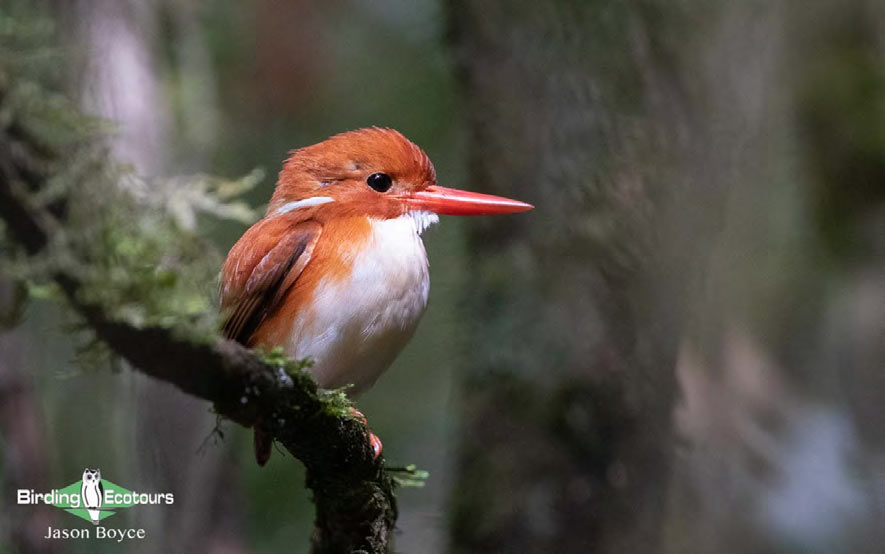 Madagascan Pygmy Kingfisher |
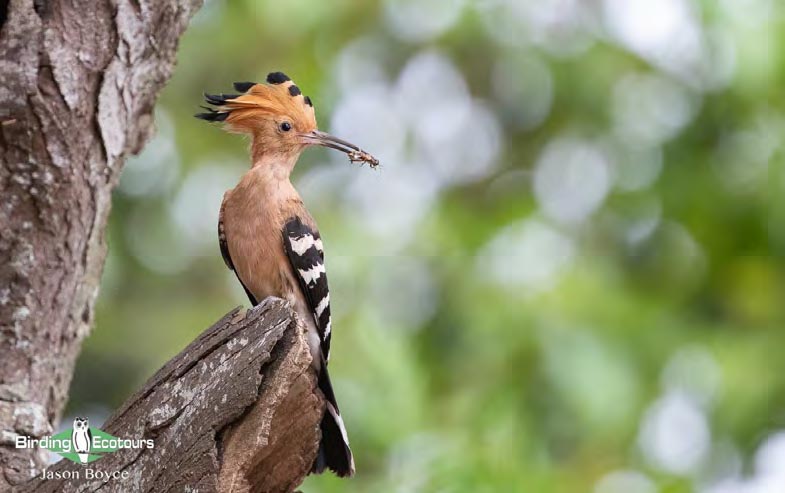 Madagascan Hoopoe |
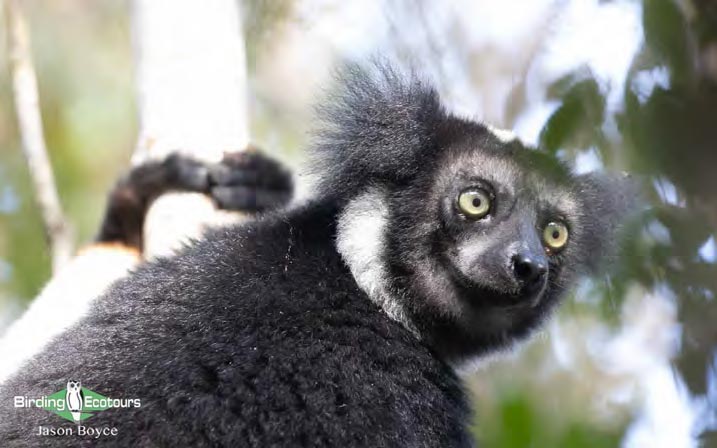 Indri. |
|
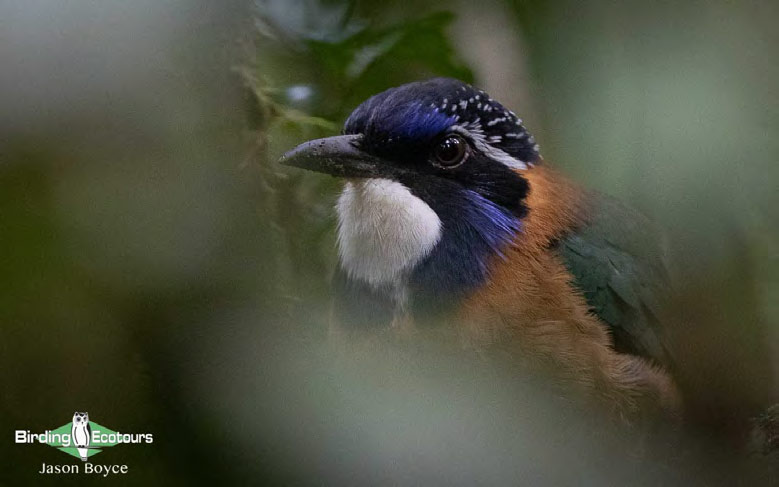 Pitta-like Ground Roller. |
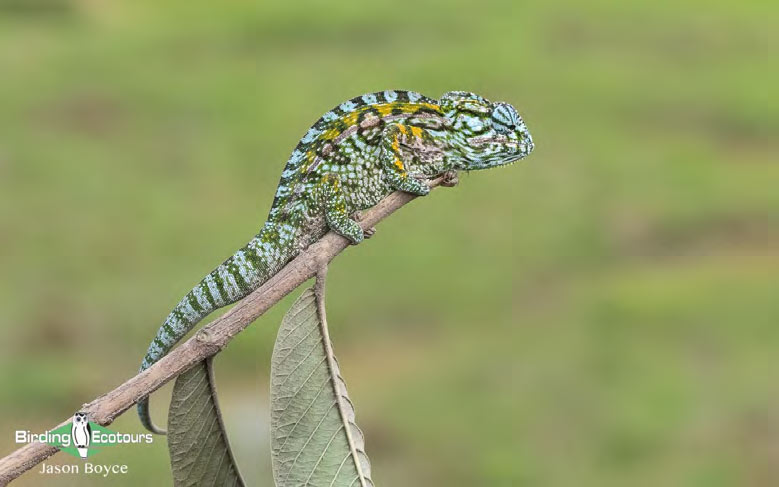 Carpet Chameleon |
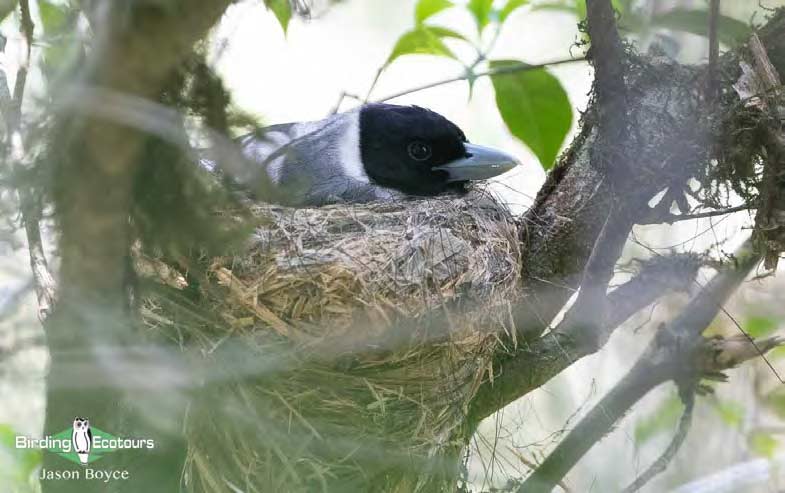 Pollen’s Vanga. |
|
Overview
The wonderful world that is Madagascar, the Eighth Continent! It’s easy to see why the world’s fourth-largest island has been given this name. There is a strong African influence in both Madagascar’s fauna and flora, but certainly there also is enough unique wildlife to justify a nickname such as this.
We started the tour at two premier rainforest sites, first Andasibe-Mantadia National Park and then Ranomafana National Park. Both sites produced incredible sightings of various ground rollers, vangas, tetrakas, asities, Cuckoo Roller, and Brown Mesite. Night walks produced incredible close-up sightings of many chameleons, frogs, and of course nocturnal lemurs such as the cute Rufous Mouse Lemur. The central plateau region on the way to the south-western coastal sites was incredibly scenic, and the birding en route in Zombitse-Vohibasia National Park was special. Here we had our first taste of the terrestrial couas as we encountered both Coquerel’s and Giant Couas, and White-browed Owl was also a treat. Toliara and Ifaty were next on the itinerary, and the Spiny Forest was fascinating. Long-tailed Ground Roller and Sickle-billed Vanga certainly stole the show, but we also enjoyed many coua species as well as the weird Subdesert Mesite. A boat trip to the tiny island of Nosy Ve was eventful and produced the expected Red-tailed Tropicbird and the unexpected Great Frigatebird.
Detailed Itinerary
Day 1, 17th October 2019 – Arrival day and local birding in Antananarivo
Our whole group arrived safely the previous day, some of the group from a successful pre-tour to the Masoala Peninsula and others from the main Johannesburg connection. It was to be a very relaxed “catch-up” day today, but even so most of the group opted to join a morning birding session at the well-known Parc Tsarasaotra. The small lake here, surrounded by scrub and various larger trees, is a great introductory birding locality. Hundreds of Red-billed Teals and White-faced Whistling Ducks overwhelm you as you enter the gates, while a few pairs of the endemic Meller’s Duck can be picked out among them. We loved watching a pair of Madagascan Hoopoes drop in alongside us to feed a chick in a cavity in a tree. Red Fody occurred in good numbers, while Common Jery and Malagasy Brush Warbler were less common. The small island in the middle of the lake has a host of various egrets and herons, many in full display and others with chicks: Great Egret, Dimorphic Egret, Western Cattle Egret, Squacco Heron, Black Heron, Black-crowned Night Heron, and, most notably, Malagasy Pond Heron. A few Madagascan Mannikins were flitting over the footpath, and a pair of Madagascan Swamp Warblers showed well in the reedbed. Another highlight was finding a White-throated Rail, which responded incredibly well to a burst of playback. It sauntered up the small bank and crossed the open path. Malagasy Kestrel and Mascarene and Brown-throated Martins as well as a few Malagasy Kingfishers were some of the last species that we added for the day. We rested up after lunch and prepared for our journey to Andasibe the following day.
Day 2, 18th October 2019 – Drive to Andasibe, birding Analamazoatra Special Reserve
We had a 6 a.m. breakfast in “Tana”, and by 7 a.m. we were on the way to one of Madagascar’s premier rainforest birding sites, Andasibe-Mantadia National Park. One or two brief stops en route produced sightings of the bizarre Hamerkop, Striated Heron, Three-banded Plover, Brown-throated Martin, African Palm Swift, and a couple of Common Sandpipers. One of the regular Madagascan Pratincole sites produced a single bird perched up on the rocks in the middle of the river.
After a long drive on a road that is unfortunately getting worse we enjoyed a much-needed lunch and rest. At the lunch stop we picked up a few great birds; here we had our first vanga sighting, that of Chabert Vanga. We also encountered some Broad-billed Rollers, Malagasy Paradise Flycatcher, Greater Vasa Parrot, and Ward’s Flycatcher.
Then we met our site guide and headed into the forest. After starting with a lovely little Rainforest Scops Owl at a day roost we soon bumped into a mixed-species flock, which included Madagascan Cuckooshrike, Blue Vanga, Crested Drongo, Forest Fody, and Stripe-throated Jery. Madagascan Wood Rail was also a real treat; a single bird was moving slowly, fairly unphased by our presence, on the forest floor. The site guides in Madagascar are the unsung heroes; they spend much time staking out birds and communicating with each other by sharing locations of tricky species in order to show their groups as much as possible. Our guide took us to a roosting Collared Nightjar next, what a bird! Nuthatch Vanga was also stunning; a single bird was seen on the nest. We also thoroughly enjoyed spending some time with a couple of lemur species here; a small group of Brown Lemurs was indeed fun to watch. But most of us were unsurprisingly more impressed by the family group of Indris nearby. The Indri mother, with an incredibly cute baby attached to its side, was unphased by our presence and continued with her day-to-day activities. We also heard a couple calling over the course of the next few days, their vocalization can give you goosebumps! The next animal we saw, we almost didn’t see; it took us a while to spot the master of camouflage, a Mossy Leaf-tailed Gecko. The way these creatures wrap themselves around a mossy tree trunk and blend in is just incredible. Our first coua was the arboreal Blue Coua, hopping through the trees in a similar way to African turacos. We went out for a night walk later that evening.
Andasibe Night Walk: Our second Short-horned Chameleon and our first Nose-horned Chameleon were seen. The latter is incredible small, one of the smallest chameleon species on the island. We also thoroughly enjoyed our first mouse lemur in the form of Goodman’s Mouse Lemur and also found a couple of Geoffroy’s Dwarf Lemurs moving around the mid-strata of the forest.
Day 3, 19th October 2019 – Andasibe-Mantadia National Park
We left fairly early for Mantadia National Park – the meaning of “mantadia” is best described by some local people as “not-made-well road”; we can confirm that the road definitely needs an upgrade. Nevertheless we arrived after picking up Blue Coua, Rand’s Warbler, Madagascan Blue Pigeon and a few Olive Bee-eaters and headed straight into the mature forest on the hunt for ground rollers. Unfortunately, try as we might, we could only hear the likes of Scaly and Short-legged Ground Rollers, but we did have a superb sighting of Pitta-like Ground Roller a couple of hours into our forest walk. We watched the bird call a number of times; the way in which it tilts its head downward and puffs up its whole throat to call was interesting to observe. Long-billed Bernieria and Malagasy Paradise Flycatcher were showing pretty well in some nearby thick forest.
We birded near a small forest lake for a while and were excited to find Red-fronted Coua nearby. A single Madagascan Spinetail cruised overhead, while more Olive Bee-eaters were hawking insects here too. The little lake held Red-billed Teal, Meller’s Duck, Madagascan Grebe, Broad-billed Roller, and Madagascan Magpie-Robin, as well as a pair of breeding Madagascan Wagtails. On the track back toward Andasibe town we stopped to try for Madagascan Flufftail, which we heard calling but did not see. Madagascan Mannikin and Madagascan Cisticola did show nicely, though. Probably the best surprise of the day came after we got back to the lodge, where we found a single Madagascan Buttonquail feeding on the open sandy section alongside a path. What a striking bird, and amazing to see for an extended period of time!
Day 4, 20th October 2019 – Analamazoatra Special Reserve and surroundings
Well, we had a remarkable morning in terms of finding birds nesting or breeding. We entered the special reserve at opening time, and within our first three hundred meters we had both Malagasy Paradise Flycatcher and Crossley’s Vanga on nests. What was really interesting is that these birds were breeding within twenty meters from each other. The Crossley’s Vanga was a pretty special sighting, both the male and the female birds coming back a couple of times with worms for the chick. A little further along we encountered a pair of White-throated Oxylabes building a nest about one meter off the ground. Madagascan Flufftail, like all flufftails, can be really tough; we heard a bird calling nearby and tried to get visuals in the undergrowth. Further on we encountered a few Common and Green Jeries as well as a breeding pair of Nelicourvi Weavers. The reserve holds some spectacular vegetation, and the hiking through the forest is beautiful. “Bird’s nest ferns” as well as different forms of Euphorbia are interesting to see up-close. We were shown where a Mossy Leaf-tailed Gecko was roosting, and once again it took some of us a good few minutes to actually see it, even though it was at eye level and within one meter from us. Other species we encountered that morning included Tylas Vanga (also breeding), Hook-billed Vanga, Common Newtonia, and Malagasy Kingfisher.
We headed back to the lodge, enjoyed a good meal, and were informed that the local guides had managed to find a Madagascan Owl. We went to find this bird in one of its usual day roosts. Later that afternoon we gave Madagascan Rail a try; we only caught glimpses but did not manage any really good visuals. We were, however, rewarded for our efforts as we found Madagascan Buzzard, one bird eating a prey item in a large tree and another seen in flight, calling. Western Barn Owl was also a nice find; a single bird appeared a good half hour before sunset, an unusual occurrence. Last but not least was an enjoyable sighting of Madagascan Nightjar that gave great fly-by views at almost exactly 6:30 p.m., the same time that it had started calling the night before.
Day 5, 21st October 2019 – Travel day south to Antsirabe
We started our journey to Tana, where we stopped for lunch before heading south to Antsirabe. We stopped a few times between the rice fields, where a Striated Heron stop soon turned into a reptile stop, and we managed to see Lateral Water Snake and a beautiful male Carpet Chameleon. Some avian species we picked up en route were Malagasy Kestrel, Mascarene and Brown-throated Martins, Dimorphic Egret, and Black Heron. We arrived safely in Antsirabe late in the afternoon and used the opportunity to stock up on supplies and run a few errands before another fairly long day’s travel tomorrow.
Day 6, 22nd October 2019 – Antsirabe to Ranomafana
We started the day by checking the gardens for bird activity, but except for Malagasy Green Sunbird and a few Red Fodies we didn’t manage to find much exciting on the avian front. A large Oustalet’s Chameleon grabbed the spotlight, however – it was great to watch it move slowly up a small tree in the gardens. The many sights along the windy road to Ranomafana certainly kept us entertained. It was interesting to see the how the Malagasy people go about their day-to-day activities in the many small villages en route. Rice paddies dominate much of the landscape in the central regions, and getting an opportunity to see the incredibly labor-intensive work of planting and re-planting serves as quite an eye-opener. Our lunch spot produced Yellow-billed Kite, Malagasy Kingfisher, and a few Madagascan Snipes. Some car trouble later that afternoon delayed us slightly, but before long we arrived in Ranomafana, enjoyed a meal, and got set for a long day tomorrow in the magnificent Ranomafana forest.
Day 7, 23rd October 2019 – Birding Ranomafana National Park
Ranomafana literally means “hot water” in Malagasy, due to the hot springs that occur in the area. The springs aren’t the only thing that’s hot, though: We had some of our best birding and animal sightings over the next two days here. Our morning started with a slightly unexpected sighting of a small flock of Helmeted Guineafowl moving along the side of the road. We spent a full morning in Ranomafana National Park and were rewarded with some great birding. The entrance to the trailhead produced African Palm Swift as well as Malagasy Black Swift, Rand’s Warbler, Chabert Vanga, and Malagasy Green Sunbird. The forest seemed more active than usual, and we soon picked up a party including Red-tailed, White-headed, Tylas, and Blue Vangas. Madagascan Cuckooshrike as well as Common Newtonia also showed well. We found a Pitta-like Ground Roller and had some good visuals. Soon afterwards a single male Milne-Edwards’s Sifaka came by for a visit. A small group of tetrakas included Spectacled and Grey-crowned Tetrakas and a single Wedge-tailed Jery. After having heard Madagascan Cuckoo for a few days without visuals we finally were able to see it. The highlight of our morning, though, was surely the pair of Brown Mesites that we managed to track down; we had great visuals of an incredibly tough-to-see bird! This was one of those trips where we managed to find many species breeding; we picked up both Pollen’s Vanga and Rufous Vanga on nests – certainly great to see for many reasons. We also encountered a few other interesting creatures. A couple of reptiles kept us entertained; Satanic Leaf-tailed Gecko as well as Brown Leaf Chameleon put on a nice display. A few Lowland Red Forest Rats (always said by rolling the “R’s” intensely) were also around skulking through the undergrowth.
We had lunch back at the lodge and made our way out again in the afternoon. Another Madagascan Owl was found at one of its roosting sites, perched very low down to the ground in comparison to our previous sighting. Our afternoon session was spent walking one of the trails to the north of the main road. A rather flat (in comparison) trail is known for the likes of Velvet Asity as well as the tricky Rufous-headed Ground Roller. We certainly hadn’t expected to pick up two of our main targets so quickly, but soon we had quick looks at Velvet Asity, and a Common Sunbird-Asity also put in a quick show before we were startled by the call of Rufous-headed Ground Roller calling very nearby. We turned our attention to this beauty, gave it a burst of playback, and were very soon looking at this stunning endemic that had come to inspect.
Ranomafana Night Walk: Ranomafana is well known for night walks, and we had a productive evening: O’Shaughnessy’s and Blue-legged Chameleons were showing well, males and females of both species. The incredibly cute (and, inside joke – “so annoying”) Rufous Mouse Lemur was curious and came right near to where we were standing. Eventually we saw a Geoffroy’s Dwarf Lemur as well – a super evening!
Day 8, 24th October 2019 – Ranomafana National Park
Our second full day at Ranomafana National Park was also a good one. We started on the northern trailhead, where we had found the Rufous-headed Ground Roller. Here we did well to find male and female Velvet Asities. Asities and Sunbird-Asities form a family of their own (Philepittidae) and are certainly some of the “odder” species to be found on the island. A small flock of Spectacled and Grey-crowned Tetrakas entertained us for a few minutes on the main trail. Brown Emutail was heard nearby, and so we did our best to get visuals of this mouse-like warbler. Our first bird was not very cooperative, but the second bird we found gave some nice visuals (with some effort). Red-fronted Coua was also hanging around here, and we had a nice look at it too. Thanks to our sharp-eyed local guide we also picked up a brilliant male O’Shaughnessy’s Chameleon in this area. A mammalian highlight of the morning was Ring-tailed Vontsira (Ring-tailed Mongoose) – a pair of these interesting mongoose-like animals rushed out on the path in front of us as we headed back to the vehicle.
Later in the afternoon we headed to some marsh areas to give Grey Emutail, among other things, a try. The emutail played hard to get, but we had great visuals on our second attempt. We were incredibly surprised when we noticed another Western Barn Owl cruising during daylight hours over some of the indigenous woodland.
Day 9, 25th October 2019 – Travel to Isalo National Park
We had an early breakfast and left Ranomafana behind after some great birding and wildlife sightings. Our first stop would be the Anja Reserve run by local communities in the area. Having as few as forty a few decades ago, Anja is now home to over four hundred Ring-tailed Lemurs. It was in fact National Lemur day today, and perhaps that brought us the luck we needed as we enjoyed a once-in-a-lifetime experience with a few different groups of Ring-tailed Lemurs, three-week-old youngsters as well. We continued south toward Isalo National Park, picking up Madagascan Lark at a few roadside locations. We did enjoy watching flocks of Yellow-billed Kites feeding on grasshoppers that were escaping some grassland fires. Forest Rock Thrush of the bensoni subspecies was also found not long before we arrived at Isalo. The incredible sandstone rock formations behind the lodge make for a beautiful setting! Once again Madagascan Nightjar was very active at dusk in the hotel grounds.
Day 10, 26th October 2019 – Isalo to Ifaty via Zombitse-Vohibasia National Park
A morning walk around the grounds of the lodge was beautiful. The riverine woodland, small agricultural fields, and some fantastic rocky landscapes produced a few nice bird species, which included Broad-billed Roller, Pied Crow, Olive Bee-eater, Namaqua Dove, Madagascan Cisticola, Malagasy Kestrel, and a pair of Madagascan Hoopoe. We made sure to arrive in Zombitse-Vohibasia National Park before things started to get too hot and spent a good three hours in the reserve. Appert’s Tetraka was one of our first targets, and we got great visuals of a pair moving low across the forest floor. Long-billed Bernieria and Common Newtonia were also in attendance. The bizarre Cuckoo Roller was literally all over, with birds displaying on the wing above the forest canopy all morning. We also had a few visuals of this species perched. It wasn’t long before we found both Coquerel’s and Giant Couas, both ground-dwelling coua species that we were able to follow until we managed to get good visuals through some dense foliage. We also went to see a White-browed Owl that the local guides had found for us, a fantastic way to end the morning. Madagascar is known for hosting six species of baobab trees, and today we saw our first species of the trip, Adansonia za, known as Bozy in Malagasy, one of two baobab species endemic to Madagascar.
From Zombitse-Vohibasia we continued south toward Toliara. En route we stopped for a couple of key species, but a few more common birds were encountered first, namely Madgascan Lark, Namaqua Dove, and Crested Drongo. After quite a search we did pick up both Verreaux’s Coua and a cooperative Red-shouldered Vanga! We knew that we would not have the chance to find these two species at the Spiny Forest near Ifaty. The day was coming to an end, so we checked in and enjoyed a fantastic meal and a couple of drinks.
Day 11, 27th October 2019 – Birding the Spiny Forest
We were on the road by 4:50 a.m., and before sunrise we had begun our walk in one of Madagascar’s most extraordinary habitats, the Spiny Forest. The flora here is so different from other areas of Madagascar, certainly worth a walk just for the exciting plants. In terms of birds we had a great morning as well. Our first sightings were of two coua species, a Running Coua and the “green-capped” oliveiceps subspecies of Red-capped Coua. Common and Stripe-throated Jery were calling all over the place, while small flocks of Grey-headed Lovebirds came cruising by a few times. More common species here included Crested Drongo and Souimanga Sunbird. We were very fortunate to see Subdesert Mesite on a nest that the local guides had managed to stake out for us; we had great visuals of this member of one of Madagascar’s endemic families. Surely a candidate for “bird of the trip” (let alone bird of the morning) was the stunning Long-tailed Ground Roller which, even though it shows a bright azure-blue in its plumage, can blend in pretty well with its surroundings. A pair of Archbold’s Newtonias was the center of attention for a few minutes as they came into some small, scrubby bushes right between members of our group. Our next specials were a couple of very sought-after vangas. Lafresnaye’s Vanga called while we were still taking pictures of the Long-tailed Ground Roller – we turned our attention to it and were incredibly lucky to see it perched right on top of one of the larger surrounding Octopus Trees (Didierea madagascariensis) – a great sighting of a fairly tough-to-see bird. Next was Sickle-billed Vanga, but this species was certainly more difficult to find. Luckily its call carried quite a distance through the vegetation, and after a couple of kilometers of walking through its known haunts we found a pair and had great visuals of a male bird sitting up, calling rather loudly.
After we left the wonderful Spiny Forest behind, Madagascan Plover was next on our agenda. A known site produced one in a rather short time. The large Humblot’s Heron was a little more challenging; we searched the mangroves that can be visible from the main road to Ifaty and found one wading pretty deep in the ocean. That was the end of a seriously productive morning; it was time for brunch and a good rest until later that afternoon, when we would “mop-up” a few things we may have missed. One of the very few species we had missed was Thamnornis, and we thought that it was going to be “the one that got away” until our local site guide exclaimed: “Thamnornis!” with some gusto. We had superb close-up looks. Madagascan Sparrowhawk showed briefly too. We took some time to observe the incredible flora in the forest, getting pictures of the various plants and baobabs too. We stayed in the Spiny Forest as the sun set and got our torches and night gear ready to see what nocturnal life we could find.
Spiny Forest night walk: It had been so hot today, and it didn’t cool down much after sunset. Nevertheless we stayed out and were rewarded with a couple of lemurs. First was the tiny Grey Mouse Lemur, of which we ended up seeing another later on in the evening too. Our second lemur was White-footed Sportive Lemur. Last but certainly not least was a magical sighting of a Lesser Hedgehog Tenrec – I had previously only seen it in the small ball that they roll themselves into as a defense, but this one walked around a bit, allowing us to see it really nicely.
Day 12, 28th October 2019 – Boat trip to Nose Ve
One of the more adventurous day trips on the tour is the day to the beaches of Anakao and then to the island of Nose Ve for Red-tailed Tropicbird. We started the day with an early breakfast and then made our way to the boat dock and began our journey south. We encountered a number of Greater Crested Terns flitting around between the many colorful local fishing vessels that were out on the water. It was a good morning to be on the ocean; the wind hadn’t picked up yet, and the water was beautiful. Flying fish sightings were also fun. We arrived safely in Anakao and took a walk to look for Littoral Rock Thrush. For a while we were wondering if someone super-glued the rock thrush to the top of a small tree behind a lodge as we sat watching it for some time before it moved off. Here we also encountered Sakalava Weaver, Red Fody, and many Subdesert Brush Warblers.
After some good Madagascan coffee we jumped back into the boat and headed for Nose Ve. We stopped on the northern side of the island and took a walk south, during which we picked up Grey Heron, Greater Crested Tern, Dimorphic Egret, and soon Red-tailed Tropicbird. These tropicbirds breed on this island and are a real treat to see. They were soon considered second-best, though, as a frigatebird was spotted in the distance! Any frigatebird here is a pretty decent sighting, and eventually we got close-up looks at a female Great Frigatebird! Well done, Eric! This was almost the last bit of wildlife viewing we had for the day, because the wind came up and we started our travels back to the lodge in Toliara.
Days 13-14, 29th- 30th October 2019 – Birding around Toliara and return to Antananarivo
A small wetland site called Belalanda to the north of Toliara is good for shorebirds and other waterfowl; we spent the morning here before heading back for brunch. Upon arrival a small flock of about a dozen Lesser Flamingos were nice to see as well as many Kittlitz’s Plovers. Other shorebirds here included Curlew Sandpiper, Common Ringed Plover, Common Sandpiper, and Whimbrel. One of our main target birds here was Baillon’s Crake, which we managed to hear calling in the reedbeds and with a bit of work managed to see in open sections between the reeds. Black-winged Stilt and Little Grebe were both very active and rather noisy too. A single Malagasy Kingfisher was around, and both Madagascan Cisticola and Red Fody were visible on the surrounding scrubby bushes. Some ducks, including White-faced Whistling Duck and Red-billed Teal, were seen before we headed back after an enjoyable morning.
This pretty much marked the end of our tour, because some flight issues (which Air Madagascar is well-known for) meant that we had to head back earlier than planned. A rest day in Antananarivo was welcomed by the group before many of them continued on to other tours in Southern Africa.
It is almost impossible to decide on the five best birds of this tour, but here are the 10 “most popular” birds and mammals of the tour as voted for by local guides, the participants, and me as the tour leader (in no particular order):
Diademed Sifaka, Madagascan Pygmy Kingfisher, Brown Mesite, Rufous-headed Ground Roller, Ring-tailed Lemur, Giant Coua, Long-tailed Ground Roller, Sickle-billed Vanga, Great Frigatebird, Baillon’s Crake
Bird List - Following IOC (9.2)
Birds ‘heard only’ are marked with (H) after the common name, all other species were seen.
The following notation after species names is used to show conservation status following BirdLife International: EN = Endangered, VU = Vulnerable, NT = Near Threatened.
Common Name Scientific name
Guineafowl (Numididae)
Helmeted Guineafowl Numida meleagris
Ducks, Geese, Swans (Anatidae)
White-faced Whistling Duck Dendrocygna viduata
Knob-billed Duck Sarkidiornis melanotos
Hottentot Teal Spatula hottentota
Meller's Duck - EN Anas melleri
Red-billed Teal Anas erythrorhyncha
Nightjars (Caprimulgidae)
Collared Nightjar Gactornis enarratus
Madagascan Nightjar Caprimulgus madagascariensis
Swifts (Apodidae)
Madagascan Spinetail Zoonavena grandidieri
African Palm Swift Cypsiurus parvus
Alpine Swift Tachymarptis melba
Malagasy Black Swift Apus balstoni
Cuckoos (Cuculidae)
Malagasy Coucal Centropus toulou
Crested Coua Coua cristata
Verreaux's Coua Coua verreauxi
Blue Coua Coua caerulea
Red-capped Coua Coua ruficeps
Red-fronted Coua Coua reynaudii
Coquerel's Coua Coua coquereli
Running Coua Coua cursor
Giant Coua Coua gigas
Red-breasted Coua (H) Coua serriana
Madagascan Cuckoo Cuculus rochii
Mesites (Mesitornithidae)
Brown Mesite - VU Mesitornis unicolor
Subdesert Mesite - VU Monias benschi
Pigeons, Doves (Columbidae)
Rock Dove Columba livia
Malagasy Turtle Dove Nesoenas picturatus
Namaqua Dove Oena capensis
Madagascan Blue Pigeon Alectroenas madagascariensis
Flufftails (Sarothruridae)
Madagascan Wood Rail Mentocrex kioloides
Madagascan Flufftail Sarothrura insularis
Rails, Crakes & Coots (Rallidae)
Madagascan Rail - VU Rallus madagascariensis
White-throated Rail Dryolimnas cuvieri
Baillon's Crake Porzana pusilla
Common Moorhen Gallinula chloropus
Grebes (Podicipedidae)
Madagascan Grebe - EN Tachybaptus pelzelnii
Little Grebe Tachybaptus ruficollis
Flamingos (Phoenicopteridae)
Greater Flamingo Phoenicopterus roseus
Lesser Flamingo - NT Phoeniconaias minor
Buttonquail (Turnicidae)
Madagascan Buttonquail Turnix nigricollis
Stilts, Avocets (Recurvirostridae)
Black-winged Stilt Himantopus himantopus
Plovers (Charadriidae)
Grey Plover Pluvialis squatarola
Common Ringed Plover Charadrius hiaticula
Madagascan Plover - VU Charadrius thoracicus
Kittlitz's Plover Charadrius pecuarius
Three-banded Plover Charadrius tricollaris
White-fronted Plover Charadrius marginatus
Sandpipers, Snipes (Scolopacidae)
Whimbrel Numenius phaeopus
Curlew Sandpiper - NT Calidris ferruginea
Madagascan Snipe - VU Gallinago macrodactyla
Common Sandpiper Actitis hypoleucos
Common Greenshank Tringa nebularia
Coursers, Pratincoles (Glareolidae)
Madagascan Pratincole - VU Glareola ocularis
Gulls, Terns, Skimmers (Laridae)
Greater Crested Tern Thalasseus bergii
Tropicbirds (Phaethontidae)
Red-tailed Tropicbird Phaethon rubricauda
Frigatebirds (Fregatidae)
Great Frigatebird Fregata minor
Ibises, Spoonbills (Threskiornithidae)
Madagascan Ibis Lophotibis cristata
Herons, Bitterns (Ardeidae)
Black-crowned Night Heron Nycticorax nycticorax
Striated Heron Butorides striata
Squacco Heron Ardeola ralloides
Malagasy Pond Heron - EN Ardeola idae
Western Cattle Egret Bubulcus ibis
Grey Heron Ardea cinerea
Humblot's Heron - EN Ardea humbloti
Purple Heron Ardea purpurea
Great Egret Ardea alba
Black Heron Egretta ardesiaca
Dimorphic Egret Egretta dimorpha
Hamerkop (Scopidae)
Hamerkop Scopus umbretta
Kites, Hawks, Eagles (Accipitridae)
Frances's Sparrowhawk Accipiter francesiae
Madagascan Sparrowhawk - NT Accipiter madagascariensis
Henst's Goshawk - NT (H) Accipiter henstii
Yellow-billed Kite Milvus aegyptius
Madagascan Buzzard Buteo brachypterus
Barn Owls (Tytonidae)
Western Barn Owl Tyto alba
Owls (Strigidae)
Rainforest Scops Owl Otus rutilus
White-browed Owl Athene superciliaris
Madagascan Owl Asio madagascariensis
Cuckoo Roller (Leptosomidae)
Cuckoo Roller Leptosomus discolor
Hoopoes (Upupidae)
Madagascan Hoopoe Upupa marginata
Rollers (Coraciidae)
Broad-billed Roller Eurystomus glaucurus
Ground Rollers (Brachypteraciidae)
Short-legged Ground Roller - VU (H) Brachypteracias leptosomus
Scaly Ground Roller - VU (H) Geobiastes squamiger
Pitta-like Ground Roller Atelornis pittoides
Rufous-headed Ground Roller - NT Atelornis crossleyi
Long-tailed Ground Roller - VU Uratelornis chimaera
Kingfishers (Alcedinidae)
Madagascan Pygmy Kingfisher Corythornis madagascariensis
Malagasy Kingfisher Corythornis vintsioides
Bee-eaters (Meropidae)
Olive Bee-eater Merops superciliosus
Caracaras, Falcons (Falconidae)
Malagasy Kestrel Falco newtoni
Peregrine Falcon Falco peregrinus
Old World Parrots (Psittaculidae)
Greater Vasa Parrot Coracopsis vasa
Lesser Vasa Parrot Coracopsis nigra
Grey-headed Lovebird Agapornis canus
Asities (Philepittidae)
Velvet Asity Philepitta castanea
Common Sunbird-Asity Neodrepanis coruscans
Vangas & Allies (Vangidae)
Red-tailed Vanga Calicalicus madagascariensis
Red-shouldered Vanga - VU Calicalicus rufocarpalis
Hook-billed Vanga Vanga curvirostris
Lafresnaye's Vanga Xenopirostris xenopirostris
Pollen's Vanga - NT Xenopirostris polleni
Sickle-billed Vanga Falculea palliata
White-headed Vanga Artamella viridis
Chabert Vanga Leptopterus chabert
Blue Vanga Cyanolanius madagascarinus
Rufous Vanga Schetba rufa
Tylas Vanga Tylas eduardi
Nuthatch Vanga Hypositta corallirostris
Dark Newtonia Newtonia amphichroa
Common Newtonia Newtonia brunneicauda
Archbold's Newtonia Newtonia archboldi
Ward's Flycatcher Pseudobias wardi
Crossley's Vanga Mystacornis crossleyi
Cuckooshrikes (Campephagidae)
Madagascan Cuckooshrike Ceblepyris cinereus
Drongos (Dicruridae)
Crested Drongo Dicrurus forficatus
Monarchs (Monarchidae)
Malagasy Paradise Flycatcher Terpsiphone mutata
Crows, Jays (Corvidae)
Pied Crow Corvus albus
Larks (Alaudidae)
Madagascan Lark Eremopterix hova
Bulbuls (Pycnonotidae)
Malagasy Bulbul Hypsipetes madagascariensis
Swallows, Martins (Hirundinidae)
Mascarene Martin Phedina borbonica
Brown-throated Martin Riparia paludicola
Reed Warblers & Allies (Acrocephalidae)
Malagasy Brush Warbler Nesillas typica
Subdesert Brush Warbler Nesillas lantzii
Madagascan Swamp Warbler Acrocephalus newtoni
Grassbirds & Allies (Locustellidae)
Grey Emutail Bradypterus seebohmi
Brown Emutail Bradypterus brunneus
Madagascan Warblers (Bernieridae)
White-throated Oxylabes Oxylabes madagascariensis
Long-billed Bernieria Bernieria madagascariensis
Cryptic Warbler (H) Cryptosylvicola randrianasoloi
Wedge-tailed Jery - NT Hartertula flavoviridis
Thamnornis Thamnornis chloropetoides
Spectacled Tetraka Xanthomixis zosterops
Appert's Tetraka - VU Xanthomixis apperti
Grey-crowned Tetraka - NT Xanthomixis cinereiceps
Madagascan Yellowbrow - NT (H) Crossleyia xanthophrys
Rand's Warbler Randia pseudozosterops
Cisticolas & Allies (Cisticolidae)
Common Jery Neomixis tenella
Green Jery Neomixis viridis
Stripe-throated Jery Neomixis striatigula
Madagascan Cisticola Cisticola cherina
White-eyes (Zosteropidae)
Malagasy White-eye Zosterops maderaspatanus
Starlings, Rhabdornis (Sturnidae)
Common Myna Acridotheres tristis
Madagascan Starling Hartlaubius auratus
Chats, Old World Flycatchers (Muscicapidae)
Madagascan Magpie-Robin Copsychus albospecularis
Littoral Rock Thrush Monticola imerina
Forest Rock Thrush Monticola sharpei
Madagascan Stonechat Saxicola sibilla
Sunbirds (Nectariniidae)
Souimanga Sunbird Cinnyris sovimanga
Malagasy Green Sunbird Cinnyris notatus
Weavers, Widowbirds (Ploceidae)
Nelicourvi Weaver Ploceus nelicourvi
Sakalava Weaver Ploceus sakalava
Red Fody Foudia madagascariensis
Forest Fody Foudia omissa
Waxbills, Munias & Allies (Estrildidae)
Madagascan Mannikin Lepidopygia nana
Wagtails, Pipits (Motacillidae)
Madagascan Wagtail Motacilla flaviventris
Total seen 149
Total heard only 6
Total recorded 155
Mammal List
Common name Scientific name
Tenrecs (Tenrecidae)
Lesser Hedgehog Tenrec Echinops telfairi
Dwarf and Mouse Lemurs (Cheirogaleidae)
Geoffroy’s Dwarf Lemur Cheirogaleus major
Goodman's Mouse Lemur Microcebus lehilahytsara
Grey Mouse-lemur Microcebus murinus
Rufous Mouse Lemur Microcebus rufus
True Lemurs (Lemuridae)
Brown Lemur Eulemur fulvus
Red-bellied Lemur Eulemur rubriventer
Golden Bamboo Lemur Hapalemur aureus
Ring-tailed Lemur Lemur catta
Red Ruffed Lemur Varecia variegata
Sportive Lemurs (Lepilemuridae)
White-footed Sportive Lemur Lepilemur leucopus
Indriids (Indriidae)
Indri Indri indri
Diademed Sifaka Propithecus diadema
Milne-Edward's Sifaka Propithecus edwardsi
African and Malagasy Rats (Nesomyidae)
Lowland Red Forest Rat Nesomys audeberti
Malagasy Mongooses (Eupleridae)
Ring-tailed Vontsira Galidia elegans
Total 16